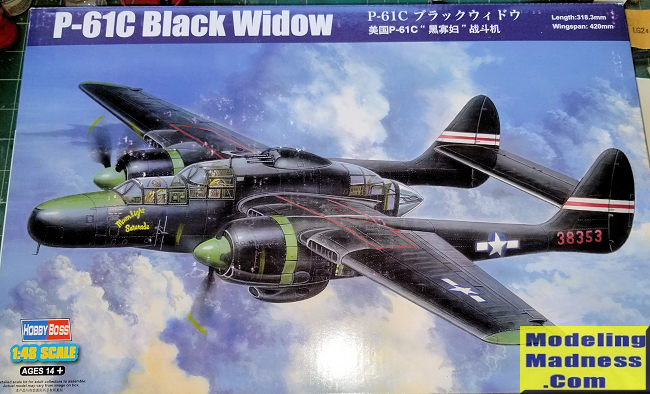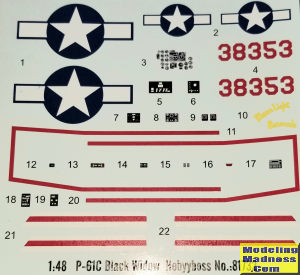
Hobby Boss 1/48 P-61C Black Widow
| KIT #: | 81732 |
| PRICE: | $56.00 |
| DECALS: | Two options |
| REVIEWER: | John Summerford |
| NOTES: | I |

| HISTORY |
This information is courtesy of Wikipedia.
The Northrop P-61 Black Widow, named for the North American spider, was the first operational U.S. warplane designed as a night fighter, and the first aircraft designed to use radar. The P-61 had a crew of three: pilot, gunner, and radar operator. It was armed with four 20 mm (.79 in) Hispano M2 forward-firing cannon mounted in the lower fuselage, and four .50 in (12.7 mm) M2 Browning machine guns mounted in a remote-controlled dorsal gun turret.
It was an all-metal, twin-engine, twin-boom design developed during World War II. The first test flight was made on May 26, 1942, with the first production aircraft rolling off the assembly line in October 1943. The last aircraft was retired from government service in 1954.
Although not produced in the large numbers of its contemporaries, the Black Widow was effectively operated as a night-fighter by United States Army Air Forces squadrons in the European Theater, Pacific Theater, China Burma India Theater, and Mediterranean Theater during World War II. It replaced earlier British-designed night-fighter aircraft that had been updated to incorporate radar when it became available. After the war, the P-61—redesignated the F-61—served in the United States Air Force as a long-range, all-weather, day/night interceptor for Air Defense Command until 1948, and Fifth Air Force until 1950.
On the night of 14 August 1945, a P-61B of the 548th Night Fight Squadron named Lady in the Dark was unofficially credited with the last Allied air victory before VJ Day. The P-61 was also modified to create the F-15 Reporter photo-reconnaissance aircraft for the United States Army Air Forces and subsequently used by the United States Air Force.
| THE KIT |
 I
I nside a
sturdy cardboard box are nine sprues of gray plastic, all but two
individually bagged. A sprue of clear parts is wrapped in foam and bagged.
The nose is molded in clear resin and also individually wrapped. Cowls are
cast in gray resin. The last parts are cast metal and double as ballast
weights. Detail is crisp with the panel lines being restrained recesses and
the raised detail is appropriate.
nside a
sturdy cardboard box are nine sprues of gray plastic, all but two
individually bagged. A sprue of clear parts is wrapped in foam and bagged.
The nose is molded in clear resin and also individually wrapped. Cowls are
cast in gray resin. The last parts are cast metal and double as ballast
weights. Detail is crisp with the panel lines being restrained recesses and
the raised detail is appropriate.
 A 16-page
instruction booklet includes a parts map with footnotes about unused items.
Assembly is divided into 18 steps. Sub-assemblies are broken down into
fuselage, booms with landing gear down, wings, engine nacelles, and
stabilizer/elevator. A color sheet (which is optimistic being as, like the
Model T, the only color is black) illustrates decal placement. Paint colors
are referenced to Mr. Hobby, Vallejo, Model Master, Tamiya and Humbrol
brands.
A 16-page
instruction booklet includes a parts map with footnotes about unused items.
Assembly is divided into 18 steps. Sub-assemblies are broken down into
fuselage, booms with landing gear down, wings, engine nacelles, and
stabilizer/elevator. A color sheet (which is optimistic being as, like the
Model T, the only color is black) illustrates decal placement. Paint colors
are referenced to Mr. Hobby, Vallejo, Model Master, Tamiya and Humbrol
brands.
| CONCLUSIONS |
The fit of the parts should be good. The biggest challenge could be getting all of the sub-assemblies to line up properly. I’m concerned that the instructions call for the landing gear and engines/props to be attached before the final assembly, leaving them exposed to damage. I checked the landing gear struts and wheel bays plus doors to see if it was possible to install the gear after assembling the airframe and that looks to be the case.
Since this kit is in 1/48th scale, the build will result in fairly large model.
Back to the Main Page Back to the Previews Index Page
Back to the Previews Index Page